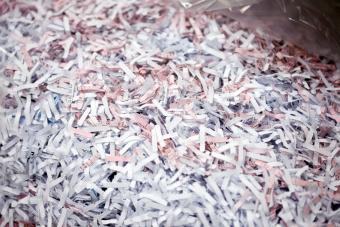
You can save money and reduce your environmental impact by using homemade cat litter. There are several easy cat litter substitutes you can create using household items like sand, newspapers, and wood shavings. Each has advantages and disadvantages you should consider before deciding which DIY option is best for you and your kitty.
With a little more commitment, however, you can save even more money and reduce your environmental footprint further by toilet training your cat. It can be done! LoveToKnow hired a veterinarian to detail the successful process in our LoveToKnow eBook -- get your copy!
1. Shred Newspaper and Junk Mail
One of the easiest materials to use in the cat's litter box is plain newspaper. After all, it is what the vet suggests after surgeries and during wound healings to keep the areas clean. Newspaper is plentiful, it is cheap, and your cat may even be willing to use it. On the other hand, they may not. If that's the case, you may need to find a way to attract them to it.

Disadvantages of Newspaper as a Kitty Litter Substitute
One of the negative aspects of using newspaper is that you will need a lot of it because you'll need to change it frequently. The paper will get wet and soiled quickly. You can ask neighbors to save newspapers for you, and you may also want to check with the local newspaper. They may be willing to give you the outdated papers. You can also shred your junk mail.
Using Newspaper as Kitty Litter
In order to use newspaper for homemade cat litter, you will need to shred it. A shredder can make this a quick and easy job. Shredded paper works best if it is shredded in long, thin strips and a generous amount is added to the litterbox.
2. Use Wood Shavings or Sawdust
Unless you have a woodworking shop, shavings and sawdust are not quite homemade, but they can work as litter. They are also fairly inexpensive.

Finding Sawdust Cat Litter
Most feed stores have shavings baled for use in horse stalls. These shavings are very inexpensive and can work very well as a litter box liner. Since wood has a natural scent, it can often cover up the ammonia smell caused by cat urine. You may also be able to contact a local cabinet shop (or other woodworking company) and get the wood shavings and sawdust for free.
A Caution About Sawdust as Cat Litter
According to Cancer.org and Verywell Health, wood dust, also referred to as sawdust, is a known human carcinogen. This means it might be a carcinogen to cats as well. Given this information, you should consider carefully whether wood shavings or sawdust are your best options. It should also be noted that shavings are possibly the better choice between the two, since sawdust is more likely to be breathed in by a cat when using their litter box and can cause respiratory symptoms.
3. Try Chicken Feed
This article on making homemade cat litter suggests using a combination of chicken feed, baking soda, and cedar shavings. However, some cat owners solely use chicken feed and find it to be effective.

Disadvantages of Chicken Feed as Cat Litter
While this type of litterbox substrate may be very absorbent, it would also potentially attract mice, rats, and bugs. If you decide to try this method, you will need to monitor the kitty litter box very closely to ensure that it isn't causing a problem.
4. Use Sand as Cat Litter
It's no secret that cats seem to be attracted to children's sandboxes. You can create the same attractive setting inside by using sand in the kitty litter box. Sand clumps very well when it is wet and does not hold cat urine odors.

Disadvantages of Sand as Cat Litter
The downside of using sand as kitty litter is that it is easily tracked all over the house in your cat's paws. A litter box mat can help cut down on the tracking. For added odor protection, add about one cup of baking soda to the sand and mix it well.
5. Make Homemade Clumping Cat Litter From Dish Soap and Baking Soda
According to TreeHugger.com, you can make a commercial style cat litter out of newspaper, water, dish soap, and baking soda. The process takes about an hour. You shred the paper and add the water and dish soap. You drain it, rinse, and add baking soda and then crumble and dry. The consistency that results is more like conventional kitty litter than any of the other options.

Why Not Just Buy Kitty Litter?
There are many valid reasons to avoid the use of commercial cat litters. Some of these reasons include:
- Expense - Commercial cat litters can be expensive, and you have to purchase them often.
- Health concerns - Clay based litters are thought to contain carcinogens, and they can create or worsen allergy and asthma problems.
- Environmental and safety concerns - Clay for the kitty litter is strip-mined while flushable litter may contaminate the water.
- A desire to be more self-reliant - As more people choose to follow a clean lifestyle, the idea of making your own products is gaining in popularity.
DIY Cat Litter Success
You can use other items besides commercially produced cat litter to fill your cat's litterbox, although it may take quite a bit of experimentation to find which litter works best for both you and your pet. Homemade kitty litter can be better for the environment and your budget than other options, but it will probably take a lot of patience and trial and error for you to find a homemade litter that really works for you.







